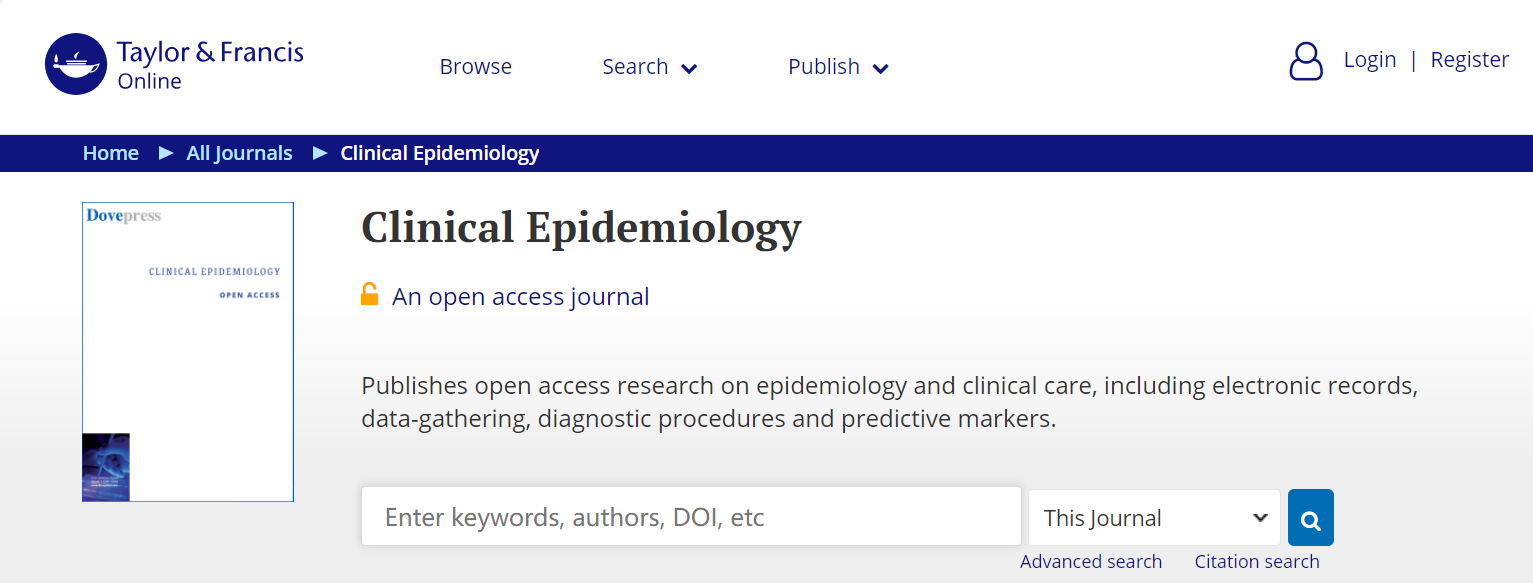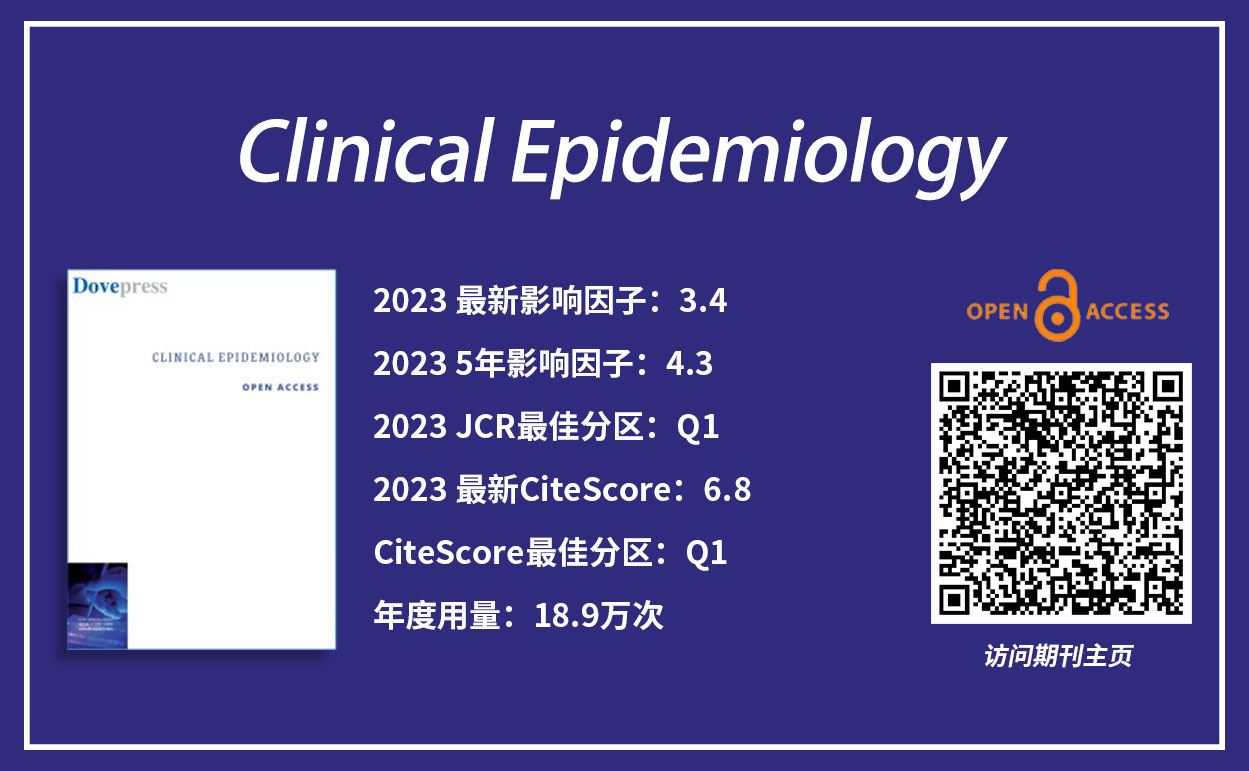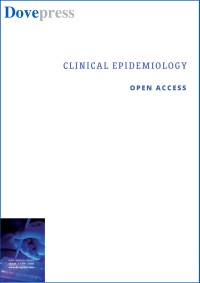博文
JCR最新分区Q1好刊,Clinical Epidemiology关注公共卫生领域新动向!
 精选
精选
||
本期向您介绍 “公共卫生、环境卫生与职业卫生”领域优秀期刊Clinical Epidemiology。

在上个月中国科学院文献情报中心发布的GoOA《2023年OA期刊白名单》中出现了它的身影。根据科睿唯安(Clarivate)本周最新发布的2024年度《期刊引证报告》显示,此刊位列JCR Q1分区。本刊发表关于流行病学和临床护理的开放获取研究,包括电子记录、数据收集、诊断程序和预测标记等。
除了对期刊进行详细介绍外,还将向您介绍刊内近三年高被引文章,以及近一年高阅读量文章:
北欧基于注册系统的健康研究:回顾医疗保健系统和关键登记册
1990-2017年全球缺血性心脏病负担及可归因风险因素:基于《2017年全球疾病负担研究》的二次分析
2018年至2023年丹麦的司美格鲁肽(Ozempic®)使用情况:用户趋势和非标签用作减肥的处方情况

Online ISSN: 1179-1349
Clinical Epidemiology 是一份国际性、同行评审的开放获取期刊。期刊涉及的主题包括:电子病历的使用;常规医疗保健数据,尤其是应用于医疗干预的安全性方面的数据;诊断程序和筛查的临床实用性;了解疾病的短期和长期临床过程;预后和预测标记;临床流行病学和生物统计学方法;系统回顾;二级和三级预防等。
该期刊已被SCIE、Scopus、DOAJ、PubMed、EMBASE等国际知名数据库收录。

2023最新影响因子:3.4
2023 5年影响因子:4.3
2023 JCR最佳分区:Q1
2023最新CiteScore:6.8
CiteScore最佳分区:Q1
年度用量:18.9万次
影响因子
根据JCR显示,Clinical Epidemiology
Impact Factor(2023)为3.4
公共卫生、环境卫生与职业卫生领域排名92/403
CiteScore
根据Scopus显示,Clinical Epidemiology
CiteScore(2023)为6.3
医学:流行病学排名41/148
中国科学院分区表
根据2023年12月27日发布的中国科学院文献情报中心期刊分区表(升级版)显示:
大类及分区:医学2区
小类及分区:公共卫生、环境卫生与职业卫生2区
作者须知
收稿文章类型
Clinical Epidemiology欢迎原创研究、评论和国际数据库描述等形式的论文。
审稿周期与接受率
从提交稿件到获取初审意见,平均需要33天
获取首个同行评审决定,平均需要16天
文章出版费(APC)
请访问期刊主页或Taylor & Francis Open Access APC Cost Finder查找适用于作者所在国家及不同文章类型的费用情况。若您所在的机构或相关资助者与我们签有开放获取出版协议,您可能有资格获得APC支持,请访问我们的作者服务网站以了解更多!

Taylor & Francis现已开通APC便捷支付功能,可以一键通过微信、支付宝和银联使用人民币便捷付款。
编辑团队
Clinical Epidemiology的主编由Henrik Sørensen(丹麦奥胡斯大学)担任,副主编及编委团队由来自多国的医学专家组成。编委成员包括北京大学公共卫生学院院长、重大疾病流行病学教育部重点实验室主任、北京大学第三医院临床流行病学研究中心主任詹思延教授。
主编介绍
Henrik Sørensen

丹麦奥胡斯大学临床流行病学系负责人。主要研究方向:
1. 慢性疾病长期预后的决定因素,特别是临床路径以及多种慢性疾病、并发症和结果之间的相互作用;
2. 医疗干预和治疗的安全性观察研究;
3. 临床流行病学方法——使用常规卫生保健数据和大型数据集;
4. 心血管和癌症流行病学等。
作者分布
根据JCR显示,近三年在Clinical Epidemiology发文的国家中,发文数量排名前三位的是:
丹麦、美国、中国
根据JCR显示,近三年在Clinical Epidemiology发文的全球高校和科研机构中,发文数量排前三位的是:
奥胡斯大学、南丹麦大学、哥本哈根大学
近三年内高被引文章

Nordic Health Registry-Based Research: A Review of Health Care Systems and Key Registries
北欧基于注册系统的健康研究:回顾医疗保健系统和关键登记册
作者:Laugesen, K. et al.
Abstract
The Nordic countries are Denmark, Finland, Iceland, Norway, and Sweden and comprise a total population of approximately 27 million. The countries provide unique opportunities for joint health registry-based research in large populations with long and complete follow-up, facilitated by shared features, such as the tax-funded and public health care systems, the similar population-based registries, and the personal identity number as unique identifier of all citizens. In this review, we provide an introduction to the health care systems, key registries, and how to navigate the practical and ethical aspects of setting up such studies. For each country, we provide an overview of population statistics and health care expenditures, and describe the operational and administrative organization of the health care system. The Nordic registries provide population-based, routine, and prospective data on individuals lives and health with virtually complete follow-up and exact censoring information. We briefly describe the total population registries, birth registries, patient registries, cancer registries, prescription registries, and causes of death registries with a focus on period of coverage, selected key variables, and potential limitations. Lastly, we discuss some practical and legal perspectives. The potential of joint research is not fully exploited, mainly due to legal and practical difficulties in, for example, cross-border sharing of data. Future tasks include clear and transparent legal pathways and a framework by which practical aspects are facilitated.

1990-2017年全球缺血性心脏病负担及可归因风险因素:基于《2017年全球疾病负担研究》的二次分析
作者:Wang, F. et al.
Abstract
Objective
To estimate the burden of ischemic heart disease (IHD) stratified by gender, age, geographic location, and social-demographic status for 21 regions across the world from 1990 to 2017.
Methods
Using the Global Burden of Disease Study (GBD) Results Tool, we extracted data on the incidence, mortality, disability-adjusted life years (DALYs), and age-standardized rates related to IHD, as IHD burden measures. Trend analyzes were conducted for major regions. Risk factors for DALYs (obtained from the GBD comparative risk assessment framework) were also analyzed.
Results
Globally, 10.6 million (95% uncertainty interval [UI]: 9.6–11.8) cases of IHD occurred in 2017, with 8.9 million (95%UI:8.8–9.1) IHD-related deaths. Both the age-standardized incidence rate (ASIR) and death rate (ASDR) declined from 1990 to 2017 (percentage change: 27.4% and 30.0%, respectively), with average annual percent change (AAPC) values of −1.2% and −1.3%, respectively. In 2017, the global number of IHD-related DALYs was 170.3 million (95%UI:167.1–174.0), and the middle socio-demographic index (SDI) quintile contributed the most to these DALYs. In most regions, indicators (incidence, mortality, and DALYs) declined steadily with SDI increased. High systolic blood pressure (SBP) was the most significant contributor to the DALYs in most regions, accounting for 118.18 million DALYs in 2017 globally, followed by high low-density lipoprotein cholesterol and a diet low in nuts and seeds (101.78 and 52.86 million, respectively).
Conclusion
Even though the trend in IHD morbidity and mortality decreased globally, the IHD burden remains high, particularly in regions with lower SDI. It is necessary to learn successful and effective experience in controlling IHD risks and decreasing health disparities to reduce the IHD burden.
近一年内高阅读量文章

2018年至2023年丹麦的司美格鲁肽(Ozempic®)使用情况:用户趋势和非标签用作减肥的处方情况
作者:Mailhac, A. et al.
Abstract
Purpose
A surge in the use of semaglutide injection (Ozempic®) approved to treat type 2 diabetes (T2D) has led to a global supply shortage. We investigated contemporary user rates and clinical characteristics of semaglutide (Ozempic®) users in Denmark, and the extent of “off-label” prescribing for weight loss.
Patients and Methods
Nationwide population-based cross-sectional study based on linked health registries January 2018 through December 2023. All adults who received a first prescription of semaglutide once weekly (Ozempic®) were included. We examined quarterly rates of new users and total user prevalences, using other glucagon-like peptide-1 receptor agonists and weight loss medications as comparison. We also investigated user characteristics including T2D, glucose control, comedications, and cardiorenal disease.
Results
The new user rate of semaglutide (Ozempic®) remained stable at approximately 4 per 1000 adult person-years between 2019 and 2021 and then accelerated, peaking at 10 per 1000 in the first quarter of 2023 after which it declined sharply. User prevalence increased to 91,626 users in Denmark in 2023. The proportion of semaglutide (Ozempic®) new users who had a record of T2D declined from 99% in 2018 to only 67% in 2022, increasing again to 87% in 2023. Among people with T2D who initiated semaglutide (Ozempic®) in 2023, 52% received antidiabetic polytherapy before initiation, 39% monotherapy, and 8% no antidiabetic therapy. Most T2D initiators had suboptimal glucose control, with 83% having an HbA1c ≥48 mmol/mol and 68% ≥53 mmol/mol despite use of antidiabetic medication, and 29% had established atherosclerotic cardiovascular disease or kidney disease.
Conclusion
The use of semaglutide (Ozempic®) in Denmark has increased dramatically. Although not approved for weight loss without T2D, one-third of new users in 2022 did not have T2D. Conversely, most initiators with T2D had a clear medical indication for treatment intensification, and “off-label” use can only explain a minor part of the supply shortage.
以上内容可能更新,请以期刊官网主页为准。
访问期刊主页,查看期刊最新数据和投稿详情!
https://blog.sciencenet.cn/blog-3574014-1440090.html
上一篇:BIBF圆满落幕 | 回顾Taylor & Francis的高光瞬间
下一篇:最新影响因子出炉!STEM领域Q1好刊盘点!